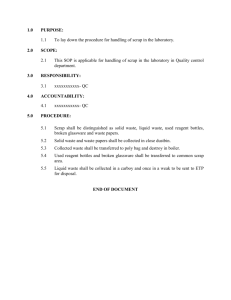Chapter 11 1 Chapter 11 Cost Allocation for Joint Products and By
advertisement
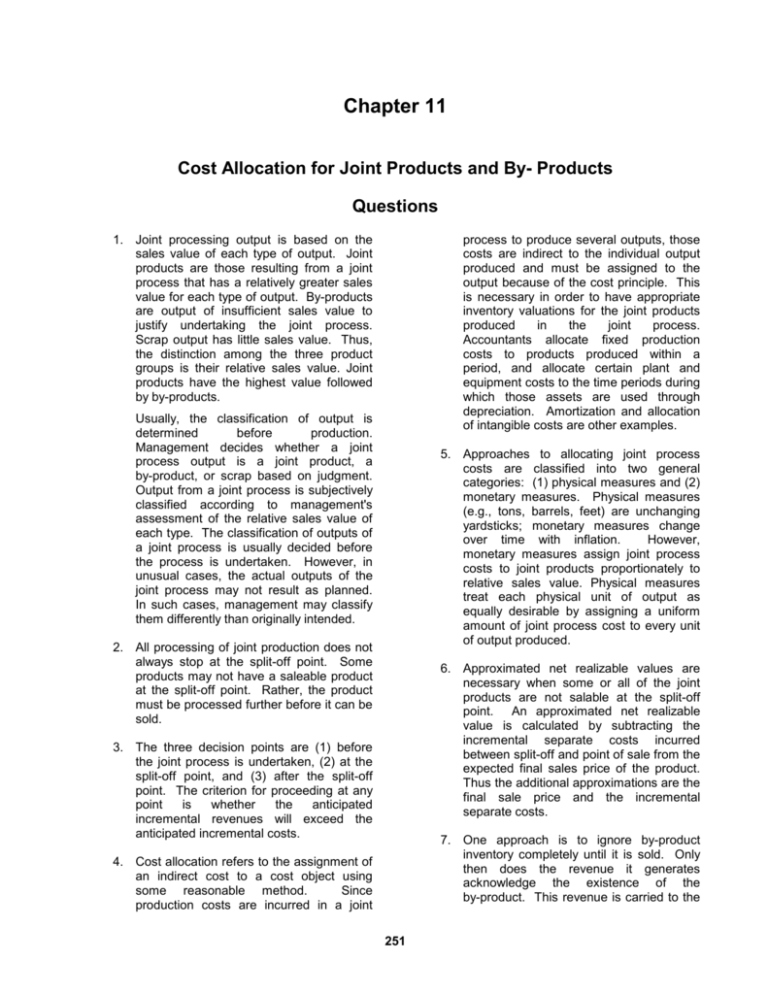
Chapter 11 Cost Allocation for Joint Products and By- Products Questions 1. Joint processing output is based on the sales value of each type of output. Joint products are those resulting from a joint process that has a relatively greater sales value for each type of output. By-products are output of insufficient sales value to justify undertaking the joint process. Scrap output has little sales value. Thus, the distinction among the three product groups is their relative sales value. Joint products have the highest value followed by by-products. process to produce several outputs, those costs are indirect to the individual output produced and must be assigned to the output because of the cost principle. This is necessary in order to have appropriate inventory valuations for the joint products produced in the joint process. Accountants allocate fixed production costs to products produced within a period, and allocate certain plant and equipment costs to the time periods during which those assets are used through depreciation. Amortization and allocation of intangible costs are other examples. Usually, the classification of output is determined before production. Management decides whether a joint process output is a joint product, a by-product, or scrap based on judgment. Output from a joint process is subjectively classified according to management's assessment of the relative sales value of each type. The classification of outputs of a joint process is usually decided before the process is undertaken. However, in unusual cases, the actual outputs of the joint process may not result as planned. In such cases, management may classify them differently than originally intended. 5. Approaches to allocating joint process costs are classified into two general categories: (1) physical measures and (2) monetary measures. Physical measures (e.g., tons, barrels, feet) are unchanging yardsticks; monetary measures change over time with inflation. However, monetary measures assign joint process costs to joint products proportionately to relative sales value. Physical measures treat each physical unit of output as equally desirable by assigning a uniform amount of joint process cost to every unit of output produced. 2. All processing of joint production does not always stop at the split-off point. Some products may not have a saleable product at the split-off point. Rather, the product must be processed further before it can be sold. 6. Approximated net realizable values are necessary when some or all of the joint products are not salable at the split-off point. An approximated net realizable value is calculated by subtracting the incremental separate costs incurred between split-off and point of sale from the expected final sales price of the product. Thus the additional approximations are the final sale price and the incremental separate costs. 3. The three decision points are (1) before the joint process is undertaken, (2) at the split-off point, and (3) after the split-off point. The criterion for proceeding at any point is whether the anticipated incremental revenues will exceed the anticipated incremental costs. 7. One approach is to ignore by-product inventory completely until it is sold. Only then does the revenue it generates acknowledge the existence of the by-product. This revenue is carried to the 4. Cost allocation refers to the assignment of an indirect cost to a cost object using some reasonable method. Since production costs are incurred in a joint 251 252 Chapter 11 income statement as an increase to net income of the period. The second approach is to record, at the split-off point, the final net realizable value of the by-products recovered. The net realizable value is credited as a reduction of the joint process costs that gave rise to the by-product. The second approach is theoretically preferable because it causes the benefit to be matched with the source of the benefit – namely, the joint process costs being incurred during the period. 8. If a company using job order costing produces a by-product or a scrap item continuously from normal production, the net realizable value of that by-product or scrap should be considered in setting the predetermined overhead rate. The estimated net realizable value of the byproduct or scrap should be deducted from total estimated overhead costs in setting the rate. When the by-product or scrap is actually sold, its net realizable value should be credited to Manufacturing Overhead. If a company using job order costing only produces a by-product or a scrap item during a particular job, then the net realizable value of the by-product/scrap should not be considered in setting the predetermined overhead rate. The net realizable value should be credited to the particular job that gave rise to the by-product/scrap. 9. For a not-for-profit to appropriately evaluate the uses of its resources, the AICPA require that multipurpose costs be allocated between program and support categories. Program expenses are those that are directly aimed at the accomplishment of the organization's charitable objectives and are considered a more valid use of resources. Comparison of support expenses to total expenses may suggest a measure of organizational efficiency. The AICPA is concerned with donors having knowledge of the relative and absolute magnitude of funds spent on fundraising. Exercises 10. Student solutions will vary. No solution provided. 11. a. In a poultry butcher shop, the major joint input is chicken and turkey meat. The major questions to be asked follow: (1) Is a poultry butcher shop really the business I want to be in? Presumably, this question has been answered in the affirmative. (2) What specific meats do I want to work with and what customers do I want to serve? The answer to this question will determine what inputs will be purchased and, to some extent, what production processes will be performed. (3) What specific cuts of poultry should be selected from the meat carcasses? The answer to this question will determine how the carcasses are cut into salable parts. (4) How much processing should I do to the individual cuts. The answer to this question will determine what specific processes will be necessary beyond the splitoff point. The answer to this question will also determine what types of equipment the poultry butcher shop must have to execute the required conversion operations. The decision to classify output as joint product, by-product, scrap, or waste is not as important in this environment because inventory levels will be minimal due to the perishable nature of the product. Rather, the focus will be on maximizing the value added to the raw carcasses that are purchased from poultry wholesalers. b. For a poultry butcher shop, the manner in which joint cost is allocated can affect some decisions. For example, in pricing products, a poultry butcher shop wants to cover all costs. To do so requires that an appropriate price Chapter 11 253 be established for each cut of meat. This price will be determined partly by the costs of each cut, and part of the cost is joint cost. The allocation of joint costs can also be important in meeting reporting requirements, e.g., income determination and inventory valuation for purposes of reporting to the Internal Revenue Service. Joint products are also relevant in determining whether one is going to engage in production. However, once the split-off point is reached in the production operation, the joint costs are irrelevant in determining whether additional conversion operations should be performed. c. Four potential categories of output are obtained from joint production. Joint products are the main products obtained and are distinguished from the other outputs by their relatively greater sales value. At the opposite end of the continuum, waste is an incidental output of a joint production process and has no value. By-products and scrap are distinguished by the fact that they both have some value but the value is substantially below that of joint products. By-product differs from scrap in that it has a somewhat larger market value. 12. a. Direct instructional costs Overhead Total costs $38,000 4,000 $42,000 Application rate = $42,000 ÷ 3,000 = $14.00 per hour Cost assignment: High School League (2,000 x $14.00) Amateur Adult (1,000 x $14.00) Total cost assigned $28,000 14,000 $42,000 b. Application rate = $42,000 ÷ [($10 x 2,000) + ($30 x 1,000)] = $0.84 per dollar of sales value Cost Assignment: High School League ($20,000 x 0.84) Amateur Adult ($30,000 x 0.84) Total cost assigned $16,800 25,200 $42,000 c. The monetary method of allocation best captures the relative incentives of providing the joint services. It is appropriate to assign Amateur Adults more cost because it generates more revenues. Alternatively, more class hours are required for High School League. If class hours are considered to be a cost driver, it is appropriate to assign more costs to the High School League. 254 13. Chapter 11 a. Allocation rate = $24,000,000 ÷ 48,000,000 = $0.50 per foot Grade A: $0.50 x 36,000,000 = $18,000,000 Grade B: $0.50 x 12,000,000 = $6,000,000 b. Incremental revenue (36,000,000 x $1.10) $39,600,000 Incremental costs (36,000,000 x $0.75) 27,000,000 Increase in income $12,600,000 Based on the incremental change in net income, the company should process Grade A Wood further. 14. a. Joint Unit Products Weight Fish 0.5 Oil 0.25 Meal 0.125 Total lbs. Produced 100,000 100,000 100,000 b. Joint Products Fish Oil Meal Pounds Produced 50,000 25,000 12,500 Product Total 50,000 25,000 12,500 87,500 Percent* 57.14 28.57 14.29 100.00 Unit Selling Price Total Proportion $6.00 $300,000 30/55 8.00 200,000 20/55 4.00 50,000 5/55 $550,000 100.00 Allocated* Joint Cost $108,795 54,397 27,208 $190,400 Allocated * Joint Cost $103,855 69,236 17,309 $190,400 *rounded c. The physical measure (pounds) is an unchanging yardstick, but it treats all pounds as equally valuable. The monetary basis assigns joint costs using sales value but, because of inflation and market price variability, is a changing yardstick. However, the monetary basis probably provides a better way of matching the joint costs to the benefits achieved from the joint production process. This is due to the substantial differences in per pound prices across the three products. 15. a. Sales value of milk Sales value of sour cream Total sales value $100,000 (31.25%) 220,000 (68.75%) $320,000 Since the milk represents 31.25% of the total sales value at split-off, $43,200 represents 31.25% of the total joint costs. Total joint costs are $138,240 ($43,200 ÷ 0.3125). b. 320,000 pints = 160,000 quarts of sour cream Quarts of milk 240,000 (60%) Quarts of sour cream 160,000 (40%) Total quarts 400,000 Since the milk represents 60% of the total physical quantity produced, $43,200 represents 60% of the total joint costs. Total joint costs are $72,000 ($43,200 ÷ 0.60). Chapter 11 16. 255 a. Revenues Separate Costs NRV Games News Documentary $18,000,000 $15,000,000 $95,000,000 (17,000,000) (8,000,000) (55,000,000) $ 1,000,000 $ 7,000,000 $40,000,000 Joint cost allocation: Games [$12,000,000 x (1 ÷ 48)] News [$12,000,000 x (7 ÷ 48)] Documentary [$12,000,000 x (40 ÷ 48)] Total Revenues Separate Costs Allocated costs Net Profit 250,000 1,750,000 10,000,000 $12,000,000 $18,000,000 $15,000,000 $95,000,000 (17,000,000) (8,000,000) (55,000,000) (250,000) (1,750,000) (10,000,000) $ 750,000 $ 5,250,000 $30,000,000 b. Joint cost allocation: Games [$12,000,000 x (18 ÷ 128)] News [$12,000,000 x (15 ÷ 128)] Documentary [$12,000,000 x (95 ÷ 128)] Total Revenues Separate Costs Allocated costs Net Profit $ $ 1,687,500 1,406,250 8,906,250 $12,000,000 $18,000,000 $15,000,000 $95,000,000 (17,000,000) (8,000,000) (55,000,000) (1,687,500) (1,406,250) ( 8,906,250) $ (687,500) $ 5,593,750 $31,093,750 c. Obviously, as head of the Games Group, a manager would be very concerned about the effects of allocating joint costs under the scheme in part (b). The result of the allocation is to make the Games Group appear to be very unprofitable. Some of the points students might make in their presentations include (some of which could be rebutted): 1. The allocation of joint costs is totally arbitrary; there is no cause and effect relationship represented in the allocations in part (b). 2. The Games Group has a different degree of utilization than the other two groups, News and Documentaries, because most of its activities originate at a different location. Evidence of this relationship can be found in the separate costs incurred by the Games Group relative to the other two groups. The allocations in part (b) fail to consider this fact. 256 17. Chapter 11 a. Units of output allocation: Total bottles = 15,000 + 20,000 + 25,000 = 60,000 Perfume (15,000 ÷ 60,000) x $240,000 Eau de Toilet (20,000 ÷ 60,000) x $240,000 Body Splash (25,000 ÷ 60,000) x $240,000 Total $ 60,000 80,000 100,000 $240,000 Weight-based allocation: Total weight = (15,000 x 3) + (20,000 x 2) + (25,000 x 3) = 160,000 Perfume (45,000 ÷ 160,000) x $240,000 Eau de Toilet (40,000 ÷ 160,000) x $240,000 Body Splash (75,000 ÷ 160,000) x $240,000 Total $ 67,500 60,000 112,500 $240,000 Approximated Net realizable value computation: Perfume 15,000 x ($8.50 - $2) Eau de Toilet 20,000 x ($6.00 - $1) Body Splash 25,000 x ($6.00 - $1.50) Total $ 97,500 100,000 112,500 $310,000 Approximated net realizable value allocation: Perfume ( 97,500 ÷ 310,000) x $240,000 Eau de Toilet (100,000 ÷ 310,000) x $240,000 Body Splash (112,500 ÷ 310,000) x $240,000 Total $ 75,484 77,419 87,097 $240,000 b. Cost assigned to inventory = allocated joint cost + separate costs Perfume $ 60,000 + ($2 x 15,000) Eau de Toilet $ 80,000 + ($1 x 20,000) Body Splash $100,000 + ($1.50 x 25,000) Total $ 90,000 100,000 137,500 $327,500 Ending inventory valuation based on bottles of output: Perfume ($ 90,000) x (500 ÷ 15,000) $ 3,000 Eau de Toilet ($100,000) x (1,000 ÷ 20,000) 5,000 Body Splash ($137,500) x (1,500 ÷ 25,000) 8,250 Total $16,250 Inventory valuation based on weight: Perfume ($ 67,500 + $30,000) x (1,500 ÷ 45,000) Eau de Toilet ($ 60,000 + $20,000) x (2,000 ÷ 40,000) Body Splash ($112,500 + $37,500) x (4,500 ÷ 75,000) Total $ 3,250 4,000 9,000 $16,250 Chapter 11 257 Inventory valuation based on approximated net realizable value: Perfume ($75,484 + $30,000) x (500 ÷ 15,000) $ 3,516 Eau de Toilet ($77,419 + $20,000) x (1,000 ÷ 20,000) 4,871 Body Splash ($87,097 + $37,500) x (1,500 ÷ 25,000) 7,476 Total $15,863 18. a. Product Butter Jam Syrup (a) (b) (c)=(a)–(b) (d) (e)=(c)–(d) Final Sales Split-off Incremental Incremental Incremental Value Sales Value Sales Costs Profit $15,000 $10,000 $ 5,000 $ 7,500 $ (2,500) 60,000 10,000 50,000 20,000 30,000 900 750 150 100 50 Only products Jam and Syrup should be processed beyond the split-off point. b. Joint costs Less NRV of Syrup ($1.80 - $0.20) x 500 Joint costs to be allocated $60,000 800 $59,200 Unit-based allocation: Butter (5,000 ÷ 15,000) x $59,200 Jam (10,000 ÷ 15,000) x $59,200 Total $19,733* 39,467* $59,200 Weight-based allocation: Butter (50,000 ÷ 110,000) x $59,200 Jam (60,000 ÷ 110,000) x $59,200 Total $26,909 32,291 $59,200 NRV computation (assuming Jam is not processed further) Butter 5,000 x ($3.00 - $1.50) $ 7,500 Jam 10,000 x ($6.00 - $2) 40,000 NRV $47,500 NRV-based allocation: Butter (7,500 ÷ 47,500) x $59,200 Jam (40,000 ÷ 47,500) x $59,200 Total $ 9,347* 49,853* $59,200 *Rounded 19. a. Final revenues Revenues at split-off Incremental revenues Incremental costs Net benefit (cost) of further processing Fabric $180,000 120,000 $ 60,000 40,000 $ 20,000 Fabric and Yarn should be processed further. b. The irrelevant item is the $40,000 of joint processing cost. Yarn $140,000 100,000 $ 40,000 34,000 $ 6,000 258 20. Chapter 11 a. Product Candied apples Apple jelly Apple jam (a) (b) (c) = (a) - (b) (d) Final Split-off Incremental Incremental Revenues Sales Value Revenue Costs (e) = (c) - (d) Incremental Profit $620,000 $642,000 ($22,000) $26,000 $(48,000) 740,000 706,000 34,000 38,000 (4,000) 270,000 253,000 17,000 15,000 2,000 Management should not have further processed candied apples and apple jelly because the incremental costs from further processing was greater than the incremental revenues. Rather, management should only further process apple jam beyond the split-off point. b. Candied apples Apple jelly Additional potential profit 21. $48,000 4,000 $52,000 a. Joint cost Less NRV of by-product 1,000 x (0.75 - 0.15) Joint cost to be allocated $64,000 (600) $63,400 NRV of Fillet 9,000 x ($6 - $1.50) NRV of Smoked 10,000 x ($6.50 - $4.50) Total NRV $40,500 20,000 $60,500 Cost allocation: Fillet $63,400 x ($40,500 ÷ $60,500) Smoked $63,400 x ($20,000 ÷ $60,500) Total cost allocation $42,441 20,959 $63,400 b. Separate costs for Fillet = 9,000 x $1.50 = $13,500 Separate costs for Smoked = 10,000 x $4.50 = $45,000 Joint costs Separate costs Total costs Divide by units Unit cost Fillet $42,441 13,500 $55,941 9,000 $6.22* Smoked $20,959 45,000 $65,959 10,000 $6.60* *rounded Inventory values: Fillet 600 x $6.00 Smoked 600 x $6.50 Canned (54 ÷ 1,000) x $600 Total inventory value $3,600.00 3,900.00 32.40 $7,532.40 Chapter 11 259 22. Because the by-products have substantial value, they should be accounted for on the basis of net realizable value rather than realized value. Use of realized value would result in distorted cost information. Whether the direct or indirect method is used would be dependent on the timing of the sale of by-products and joint products. If both product groups sell shortly after they are produced, then the choice of method is less important. However, if the by-product tends to sell in a different period than its related joint products, the use of the direct method would provide a stronger match between costs and benefits. 23. a. Joint Services Increase in Revenues Renting $ 400,000 Sales 800,000 Totals $1,200,000 1/3 2/3 1 b. Joint Services Increase in Net Income Renting $ 75,000 0.60 Sales 50,000 0.40 Totals $ 125,000 1.00 Allocated Cost $ 8,333 16,667 $25,000 Allocated Cost $15,000 10,000 $25,000 c. The allocation based on increase in net income may be better because it matches the advertising cost to the net benefit of the advertising. 24. Joint process cost Less net realizable value of by-product inventory Amount to be allocated $240,000 40,000 $200,000 Proration of amount to be allocated based on weight: Product Premium Good Fair Bushels Proportion* 9,600 0.22 26,000 0.59 8,400 0.19 44,000 1.00 Allocation $ 44,000 118,000 38,000 $200,000 *rounded 25. a. Sales value of blouses = Joint cost of blouses Total sales value Total allocated joint cost $ 40,000 = X $300,000 $180,000 $300,000 X $30X $30X X = $40,000($180,000) = $4($180,000) = $720,000 = $24,000 for blouses Total joint cost Joint cost for dresses and blouses ($87,000 + $24,000) Joint cost assigned to jackets $180,000 (111,000) $ 69,000 260 Chapter 11 b. Joint costs = 60% of relative sales value amounts; therefore, $87,000 = 0.6X X = $145,000 sales value for dresses $300,000 - $145,000 for dresses and $40,000 for blouses = sales value of $115,000 for jackets c. Final sales value Sales value at split off Increase in value Additional costs Incremental benefit (loss) Dresses $150,000 145,000 $ 5,000 (13,000) $ (8,000) Jackets $134,000 115,000 $ 19,000 (10,000) $ 9,000 Blouses $105,000 40,000 $ 65,000 (39,000) $ 26,000 Process jackets and blouses further. d. Joint costs allocated to jackets: Additional costs Total costs for 8,000 units $69,000 10,000 $79,000 Sales Cost for 4,000 units Gross profit 26. $67,000 (39,500) $27,500 a. Total joint cost Revenue from tours Expenses of tours Joint cost to be allocated $16,000,000 $700,000 (380,000) Rare D&C $8,000,000 (4,800,000) $3,200,000 Gross Revenues Separate costs Net realizable value Joint cost allocation: NRV Rare D&C $ 3,200,000 Sequel 16,800,000 $20,000,000 b. Gross Revenues Separate costs Net realizable value Joint costs Net profit 27. Sequel $54,000,000 (37,200,000) $16,800,000 Joint Cost Allocated 16% $ 2,508,800 84 13,171,200 100% $ 15,680,000 Rare D&C $8,000,000 (4,800,000) $3,200,000 (2,508,800) $ 691,200 Total sales value (24,000 x $21) Less costs (24,000 x $4) Reduction of joint cost (320,000) $15,680,000 $504,000 96,000 $408,000 Sequel $54,000,000 (37,200,000) $16,800,000 (13,171,200) $ 3,628,800 Chapter 11 261 The gross margin for the major products will decrease by $408,000, but net income will remain the same. 28. Sales of by-product Cost of by-product sales (90,000 x $0.10) Net realizable value of by-product a. $11,825 9,000 $ 2,825 Azzi Potato Inc Income Statement For May 2006 Sales of hash browns & potato chips Cost of goods sold: Hash browns & potato chips (80% x $30,000) By-products Gross profit Expenses Income from operations Other revenues (by-product sales) Net income before taxes b. $24,000 9,000 (33,000) $47,000 (3,800) $43,200 11,825 $55,025 Azzi Potato Inc Income Statement For May 2006 Sales of hash browns & potato chips Cost of goods sold Gross profit Expenses Income from operations Other income (by-product sales) Net income before taxes c. $80,000 $80,000 (24,000) $56,000 (3,800) $52,200 2,825 $55,025 Azzi Potato Inc Income Statement For May 2006 Sales of hash browns & potato chips Cost of goods sold Gross profit Expenses Net income before taxes $80,000 (21,740)* $58,260 (3,800) $54,460 *$30,000 - $2,825 = $27,175; $27,175 x 80% = $21,740. d. The approach in part (c) is better than either (a) or (b) because it consistently matches the NRV of the by-product with the costs of the joint production operations that produced the by-product. 262 29. Chapter 11 a. Estimated OH Estimated NRV of by-product Estimated OH to be covered Divided by estimated CPU time Predetermined OH rate per CPU hr. b. Cash Manufacturing Overhead $199,250 ( 9,200) $190,050 ÷ 70,000 $2.715 9,794 9,794 To record sale of by-product c. Total actual OH Total applied OH (68,400 x $2.715) Total actual NRV of by-product Underapplied overhead 30. $199,750 $185,706 9,794 $ 195,500 4,250 a. $ 67,500 ÷ 30,000 = $42.25 b. DM DL ($10 x126) OH ($2.25 x126) Total $ 210.00 1,260.00 283.50 $1,753.50 c. Cash Manufacturing Overhead Work in Process - Job XX 9.00 18.50 27.50 To record disposal value of spoiled work incurred on Job XX (the stained glass window) 31. a. Cash Work in Process - Stiles Bldg. 2,500 2,500 To record sale of Stiles model b. Cash Manufacturing Overhead To record sale of Stiles model 32. a. b. c. d. e. f. g. h. i. j. 2 1 1 2 2 1 1 2 1 2 2,500 2,500 Chapter 11 33. a. b. 263 Joint Product Fundraising Program Total Percent 0.10 0.90 1.00 Joint Cost Allocated $ 18,000 162,000 $180,000 Joint Product Fundraising Program Total Percent 0.02 0.98 1.00 Joint Cost Allocated $ 3,600 176,400 $180,000 34. Student solutions will vary. No solution provided. 35. a. Work in Process - Combining Raw Material Inventory Wages Payable Manufacturing Overhead 39,810 28,000 7,560 4,250 Work in Process - Heating Work in Process - Combining 39,810 Work in Process - Heating Raw Material Inventory Wages Payable Manufacturing Overhead Work in Process - Heating Raw Material Inventory 11,490 Work in Process - Heating Raw Material Inventory Wages Payable Manufacturing Overhead 9,210 Finished Goods - Forever Finished Goods – Fantasy Work in Process - Heating b. Joint cost allocation: Forever ($158,910 ÷ $211,880) x $51,300 Fantasy ($52,970 ÷ $211,880) x $51,300 Total 39,810 6,100 2,150 3,240 2,120 2,120 1,960 3,120 4,130 40,595 22,035 62,630 $38,475 12,825 $51,300 264 Chapter 11 Work in Process – Combining DM 28,000 39,810 To Heating DL 7,560 c. OH Bal 4,250 0 Work in Process - Heating DM 6,100 40,595 To FG – Forever DL 2,150 22,035 To FG – Fantasy OH 3,240 From Combining 39,810 DM 2,120 DM 1,960 DL 3,120 OH Bal 4,130 0 Finished Goods – Forever Beg XXX CGM 40,595 36. Finished Goods – Fantasy Beg XXX CGM 22,035 a. Joint cost allocation: Cream (80,000 ÷ 920,000) x $320,000 Skim (840,000 ÷ 920,000) x $320,000 Total $ 27,826* 292,174* $320,000 *rounded b. Beg Finished Goods CGM Goods available for sale End Finished Goods Cost of Goods Sold $ 0 320,000 320,000 (81,740)* $238,260 * Cream ($27,826 ÷ 80,000) x (80,000 – 60,000) = $ 6,957 rounded Skim ($292,174 ÷ 840,000) x (840,000 – 625,000) = 74,783 rounded Total $81,740 Sales Cost of Goods Sold Gross Margin $679,000 238,260 $440,740 c. Lakeside could test the fat content of the milk before purchase and only purchase milk that, when processed, would result in minimal loss. Chapter 11 37. 265 a. Cream Skim $54,000 ÷ 60,000 lbs = $0.90 per pound $181,000 ÷ 625,000 lbs = $0.2896 per pound b. Joint cost allocation: Cream ($72,000* ÷ $315,264) x $320,000 Skim ($243,264* ÷ $315,264) x $320,000 Total * Cream ($0.90 x 80,000) = Skim ($0.2896 x 840,000) = Total c. Beg Finished Goods CGM Goods available for sale End Finished Goods Cost of Goods Sold $ 73,082 rounded 246,918 rounded $320,000 $ 72,000 243,264 $315,264 $ 0 320,000 320,000 (81,740)* $238,260 * Cream ($73,082 ÷ 80,000) x (80,000 – 60,000) = $18,271 rounded Skim ($246,918 ÷ 840,000) x (840,000 – 625,000) = 63,199 rounded Total $81,740 Sales Cost of Goods Sold Gross Margin 38. $679,000 238,260 $440,740 a. Joint cost allocation (in millions): Oil (55 ÷ 275) x $49.8 = $ 9.96 Meal (220 ÷ 275) x $49.8 = 39.84 Total $49.80 b. Cost of goods sold (in millions): Oil ($9.96 ÷ 55) x (55 x 0.60) = $ 5.976 Meal ($39.84 ÷ 220) x (220 x 0.80) = 31.872 Total $37.848 c. Ending finished goods (in millions): Oil ($9.96 ÷ 55) x (55 x 0.40) = $ 3.984 Meal ($39.84 ÷ 220) x (220 x 0.20) = 7.968 Total $11.952 39. a. Joint cost allocation (in millions): Oil ($0.339 x 55) Meal ($0.169 x 220) Total Oil ($18.645 ÷ $55.825) x $49.8 Meal ($37.180 ÷ $55.825) x $49.8 Total *rounded = $18.645 = 37.180 $55.825 = $16.633* = 33.167* $49.800 266 Chapter 11 b. Cost of goods sold (in millions): Oil ($16.633 ÷ 55) x (55 x 0.60) = $ 9.980* Meal ($33.167 ÷ 220) x (220 x 0.80) = 26.534* Total $36.514 *rounded c. Ending finished goods (in millions): Oil ($16.633 ÷ 55) x (55 x 0.40) = $ 6.653* Meal ($33.167 ÷ 220) x (220 x 0.20) = 6.633* Total $13.286 *rounded d. Each method allocates a different amount of joint costs to the joint products and results in a different per-unit cost for each product. In problem 38 the physical measure was used to assign joint costs and more joint costs were assigned to the meal. This allocation resulted in a lower cost of goods sold number and a higher value in ending inventory. 40. a. Joint cost allocation: Checking $400,000 x ($948,750 ÷ $1,650,000) = $230,000 Credit Cards $400,000 x ($701,250 ÷ $1,650,000) = 170,000 Total $400,000 b. Revenues Joint costs Separate costs Gross margin unadjusted Insurance revenue Overall gross margin 41. Checking $948,750 (230,000) (125,000) $593,750 a. Total joint costs: Direct material Direct labor Overhead Sales value of scrap: $0.65 per lb. x 3,600 lbs. Joint cost to be allocated b. Revenues Separate costs NRV per unit Multiply by # of units produced Total NRV NRV % Credit Card Total $701,250 $1,650,000 (170,000) (400,000) (90,000) (215,000) $441,250 $1,035,000 32,500 $1,067,500 $37,500 12,000 11,000 $60,500 (2,340) $58,160 Robes Bath Towels $40.00 $22.00 (16.80) (4.60) $23.20 $17.40 x 6,000 x 12,000 $139,200 $208,800 40% 60% Chapter 11 267 Joint cost assignable to robes (40% x $58,160) Joint cost assignable to towels (60% x $58,160) WIP-Robes WIP-Towels Work in Process - Cutting $23,264 34,896 $58,160 23,264 34,896 58,160 Allocation of joint costs to robes and towels Finished Goods – Scrap Work in Process - Cutting 2,340 2,340 To record production of scrap c. Joint costs Separate costs: $16.80 X 6,000 $ 4.60 X 12,000 Total to finished goods 42. Robes $ 23,264 Bath Towels $34,896 100,800 $124,064 55,200 $90,096 a. Cutting Dept. Split-off Premium 1,500 pecks Clean & Sort $15,450 Good 2,000 pecks Fair 500 pecks b. Materials Labor Overhead Joint cost $15,000 300 150 $15,450 Package & Delivery Dept. $1,500 $30,000 $2,200 $15,000 $2,000 $500 $4,500 268 Chapter 11 c. Joint Sales Product Price Premium $30,000 Good 15,000 Add'l Cost $1,500 4,200 NRV at Joint * Split-Off Percent* Cost $28,500 73 $11,278 10,800 27 4,172 $39,300 100 $15,450 *rounded d. Raw materials Cash (A/P) 15,000 15,000 Purchase of peaches Work in Process – Clean & Sort Raw Materials Wages Payable Manufacturing Overhead 15,450 15,000 300 150 To record joint processing costs Work in Process – Packaging (Premium) Work in Process – Cutting (Good) Work in Process – Clean & Sort 11,278 4,172 15,450 To move joint production costs to Packaging and Cutting Departments Work in Process - Cutting (Good) Various accounts 2,000 2,000 To record cutting and bottling costs for Good Peaches Work in Process - Packaging (Good) Work in Process – Cutting (Good) 6,172 6,172 To move Good Peaches from the Cutting to the Packaging department Work in Process - Packaging (Premium) Work in Process - Packaging (Good) Various accounts 1,500 2,200 3,700 To record packaging and delivery costs Finished Goods (Premium) Work in Process - Packaging (Premium) 12,778 12,778 To record completed production of premium peaches Finished Goods (Good) Work in Process - Packaging (Good) 8,372 8,372 To record completed production of Good Peaches Cash Various Accounts Other Income To record sale of Fair Peaches 4,500 500 4,000 Chapter 11 269 e. Total cost Estimated NRV of scrap Joint cost to allocate Joint Product Premium Good Sales Price $30,000 15,000 $15,450 (4,000) $11,450 Add'l Cost $1,500 4,200 NRV at Split-Off $28,500 10,800 $39,300 Percent* 73 27 100 Joint * Cost $ 8,358 3,092 $11,450 *rounded f. Raw materials Cash (A/P) 15,000 15,000 Purchase of peaches Work in Process – Clean & Sort Raw Materials Wages Payable Manufacturing Overhead 15,450 15,000 300 150 To record joint processing costs Work in Process - Packaging (Fair) Work in Process – Clean & Sort 4,000 4,000 To recognize by-product Work in Process - Packaging (Premium) Work in Process - Cutting (Good) Work in Process – Clean & Sort 8,358 3,092 11,450 To allocate joint processing costs Work in Process - Cutting (Good) Various accounts 2,000 2,000 To record cutting cost for Good Peaches Work in Process - Packaging (Good) Work in Process – Cutting (Good) 5,092 5,092 To move Good Peaches from the Cutting to the Packaging department Work in Process - Packaging (Premium) Work in Process - Packaging (Good) Work in Process - Packaging (Fair) Various accounts 1,500 2,200 500 4,200 To record Packaging Cost Finished Goods (Premium) Finished Goods (Good) Finished Goods (Fair) Work in Process - Packaging (Premium) Work in Process - Packaging (Good) Work in Process - Packaging (Fair) To move completed production to finished goods 9,852 7,292 4,500 9,852 7,292 4,500 270 43. Chapter 11 a. Personal Training Joint Costs $62,800 $707,000 $753,000 $29,600 $289,000 Apparel Towels 2,510 lbs Pack & Sell $377* $1,506 *rounded b. 2,510 x ($0.60 - $0.10 - $0.05) = $1,130 (rounded) c. $36,000 + $23,800 + $3,000 - $1,130 = $61,670 d. Personal Training Apparel Gross revenues $753,000 $289,000 Separate costs: Cost of Goods Sold (194,850)* Labor (431,000) (24,000) Supplies (98,000) (700) Equipment depreciation (65,000) (1,200) Administration (113,000) (3,700) Net realizable value $ 46,000 $ 64,550 * BI + Purchases - EI = $35,000 + $181,350 - $21,500 e. Personal Training: $61,670 x ($46,000 ÷ $110,550) = $25,661 (rounded) Apparel: $61,670 x ($64,550 ÷ $110,550) = $36,009 (rounded) Chapter 11 271 f. Gross revenues Separate costs: Cost of Goods Sold Labor Supplies Equipment depreciation Administration Joint costs Operating income 44. Personal Training $753,000 Apparel $289,000 (431,000) (98,000) (65,000) (113,000) (25,661) $ 20,339 (194,850) (24,000) (700) (1,200) (3,700) (36,009) $ 28,541 a. Split-off Dept 2 $9,620 16,800 gal Juice 16,800 gal Juice $5.25 gal Dept 1 Oranges 140,000 lbs $77,900 Jelly 31,360 gal Dept 3 $6,450 39,200 gal Pulp 7,840 gal Distribution $110 b. 56,000 gallons of output in Dept. 1: Transferred to Dept. 2 (30%) 16,800 gallons Transferred to Dept. 3 (70%) 39,200 gallons c. 39,200 gallons of input to Dept. 3: Pulp (20%) 7,840 gallons Marmalade (80%) 31,360 gallons d. Sales value (7,840 x $.08) Distribution expense NRV *rounded $627* (110 $517 Jelly $3.45 gal Pulp $0.08 gal 272 Chapter 11 e. Joint Product Gallons Juice 16,800 Jelly 31,360 Sales Price $5.25 3.45 Total Separate Sales Costs $ 88,200 $9,620 108,192 5,933* NRV $ 78,580 102,259 * $6,450 - $517 f. Joint Product Juice Jelly NRV $ 78,580.00 102,259.20 $180,839.20 Joint Cost* $33,497 44,403 $77,900 Percent 43 57 100 * Total joint cost: $44,200 + $33,700 = $77,900 g. 45. Joint Product Juice Jelly Joint Cost $33,497 44,403 Separate Costs $9,620.00 $5,932.80 Total Inv. Cost % $43,117.00 x 15 $50,335.80 x 15 Value of End. Inv. $6,468 $7,550 a. Split-off Wheat 350,000 bushels $3.50/bushel Harvest $875,000 Straw 5,000 tons b. 1. By-Product Inventory – Straw Work in Process - Wheat Baling $50,000 Straw $45/ton 150,000 150,000 (5,000 tons x $30 per ton) To record completed production of by-product 2. By-product Inventory – Straw Various Production Expenses Work in Process - Wheat 225,000 50,000 175,000 (5,000 tons at $45 per ton - $50,000) To record completed production of by-product (Alternative) Work in Process - Straw Various Production Expenses To record production of by-product 50,000 50,000 Chapter 11 273 Work in Process – Straw Work in Process - Wheat 175,000 175,000 To record reduction of main product for NRV of by-product By-Product Inventory - Straw Work in Process - Straw 225,000 225,000 To record completed production of by-product 3. Work in Process - Straw Work in Process - Wheat 96,250* 96,250 To allocate joint processing costs to straw *Sales value of Wheat at split-off (70 × 5,000 × $3.50) Sales value of Straw at split-off (5,000 × $30) Total joint costs ($175 x 5,000) Proportion of straw sales value at split-off Joint costs assignable to straw Work in Process – Straw Various Production Expenses $1,225,000 (89%) 150,000 (11%) $1,375,000 $875,000 x .11 $ 96,250 50,000 50,000 Incurrence of separable processing costs of straw Finished Goods Inventory – Straw Work in Process - Straw 146,250 146,250 To record completed production of straw (CPA adapted) 46. a. Joint process cost: Direct materials Direct labor Overhead Total Less by-product NRV Amount to be allocated $40,000 23,400 10,000 $73,400 4,600 $68,800 Allocation on the basis of sales value at split-off: Product Sales Value Proportion Allocation* Tenderloin $132,000 0.5491 $37,778 Roast 86,000 0.3577 24,610 Ham 22,400 0.0932 6,412 $240,400 1.0000 $68,800 Allocation on the basis of pounds produced: Product Pounds Proportion Allocation* Tenderloin 8,600 0.2622 $18,039 Roast 13,400 0.4085 28,105 Ham 10,800 0.3293 22,656 32,800 1.0000 $68,800 *rounded 274 Chapter 11 Computation of EI values under each allocation base: Sales Value Approach: Product Allocation Units Unit Cost Units in EI Tenderloin $37,778 6,440 $5.87 1,000 Roast 24,610 16,740 1.47 2,600 Ham 6,412 8,640 0.74 1,040 EI Value $5,870.00 3,822.00 769.60 Physical Pounds Approach: Product Allocation Units Unit Cost Units in EI EI Value Tenderloin $18,039 6,440 $2.80 1,000 $2,800.00 Roast 28,105 16,740 1.68 2,600 4,368.00 Ham 22,656 8,640 2.62 1,040 2,724.80 b. 1. For financial statement purposes, the sales value approach apportions costs according to the relative market values of the products while the physical (pounds) approach allocation treats every pound of output as equally worthy. This is done by assigning the same cost per pound to all outputs ignoring that some pounds of product sell for a higher amount than others. Pounds are, however, an unchanging measure of output while dollars (sales value in the present case) change as the purchasing power of the monetary unit changes. 2. Because joint process costs are sunk, once the joint process has been conducted, these costs and the bases used to allocate them are irrelevant to decisions about processing beyond the split-off point. 47. a. With many scrap and waste materials it is often an issue of who is to bear the cost. Undoubtedly, the resulting costs in this case to the firms and society far exceeded the cost the individual or firm would have incurred to properly dispose of the hazardous waste materials. b. If caught, those involved with this type of illegal disposal of materials could be subject to damage claims, very large fines, and prison time. Furthermore, it is likely that the costs of the cleanup would be imposed on them. c. Firms have an obligation to ensure proper waste disposal and to educate their employees in proper methods of waste disposal. Employees should be made aware of the risks associated with improper disposal including the legal repercussions. Thus, the least expensive and most effective way to control waste is for each firm to assume responsibility for its own waste. Beyond internal measures, the larger society can assume a greater oversight role through increased regulation and monitoring of waste control efforts. Much of this activity is currently monitored by the EPA, but the role of this agency could be expanded. Further, we could tighten laws and improve the penalty structure for improper disposal of waste materials. Lastly, we could improve waste recycling opportunities for manufacturing firms and pursue other alternatives to reduce the costs of waste disposal. Chapter 11 275 d. The vendor/manufacturer must bear some of the responsibility for proper use and disposal of its products. Manufacturers should have superior knowledge about chemical properties and the risks associated with the components of their products. Furthermore, while giving due consideration to relative cost, manufacturers have an obligation to produce products with materials and components that are the least toxic and the most convenient to recycle. If extraordinarily toxic to the environment, manufacturers should be directly responsible for proper waste disposal.
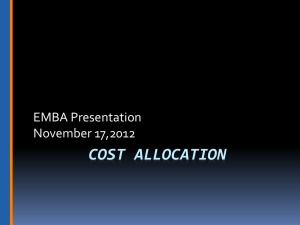
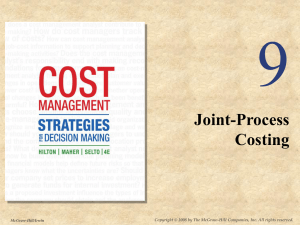
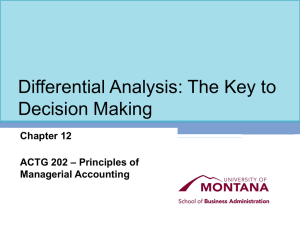
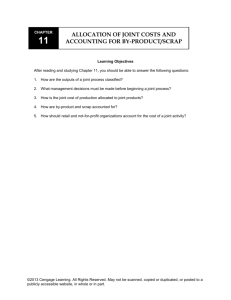

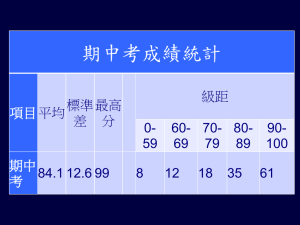
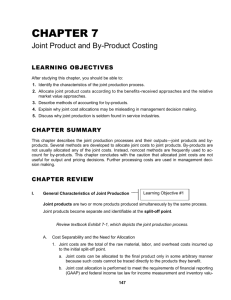
![You`re invited to celebrate [child`s name]`s birthday at SCRAP! What](http://s3.studylib.net/store/data/007177272_1-c15601fb9e11b26854f13f1982e634e8-300x300.png)

